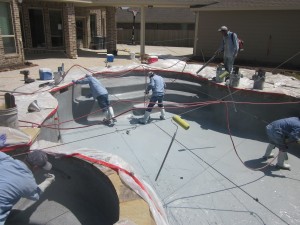The Association of Pool & Spa Professionals has published the nation’s first pool-plastering standard.
Written in collaboration with the National Plasterers Council, it is largely fashioned after the NPC Technical Manual. The voluntary standard also can be adopted by governmental bodies.
The language lists the kinds of components to use or not, and specifies some proportions. It also addresses application methods, commenting on appropriate weather conditions and curing. It states that colored plaster shall match the samples provided to the customer, and that pigment should meet a certain performance threshold.
NPC officials hope the standard will raise the professionalism level among their peers and satisfy the need of architects, particularly of commercial projects, who often seek documentation of best practices.
But the five-page standard has proved another flash point with NPC’s critic, onBalance. The organization said the standard does not address the most important workmanship factors in applying plaster, specifically mentioning issues about which the groups have wrangled for decades — the use of water and the additive calcium chloride, and late hard troweling.
“This creates a harmful situation for service techs, pool builders and remodeling contractors who are left without any guidance or backing in those cases where those critical factors are the cause of a problem,” the organization said in a statement. “They are likely to pay to re-plaster the pool while the plasterer pays nothing for the defects they caused.”
NPC officials said water amounts cannot be prescribed because each job is different, based on weather and the condition of the pool shell. “You couldn’t possibly test every scenario,” said NPC Chairman Scott McKenna, also president of Gardner Outdoor and Pool Remodeling in San Diego.
“It would have to be tested and established for us to put an actual number in it.”
As for calcium chloride use, NPC recommends 2 percent or less in its Technical Manual, but the organization said there is no conclusive data on acceptable levels in pool plaster. Rather, the Technical Manual recommendation is a precautionary measure based on findings for reinforced concrete, which contains steel that can corrode from too much calcium chloride exposure. They also cited NPC testing in which slightly higher levels did no harm.
Writers of the standard said they wanted to start with specifications on which there is widespread consensus, and the language was agreed upon by several organizations in addition to APSP and NPC, as part of the ANSI process.
“[The standard committee] had the opportunity of bringing together those portions of the plaster technology that we could get a consensus on, and I think that was legitimized by the ANSI approval process,” said Carvin DiGiovanni, APSP senior director, technical and standards.
During that process, interested parties can submit comments and alternate proposals. Several pages were filed by onBalance, it is said, but voting members did not approve proposals. OnBalance also filed an appeal to the language, which was turned down.
“It’s not necessarily unanimous, but it is an overwhelming majority of the industry that agrees with this,” McKenna said.
The standard must be revised at least every five years, leaving the door open to reconsider these issues, Di Giovanni said.



